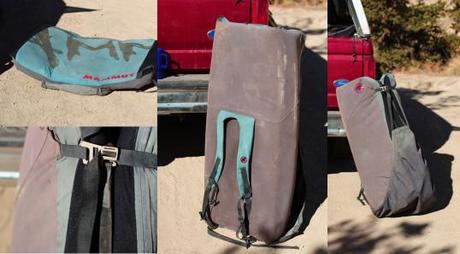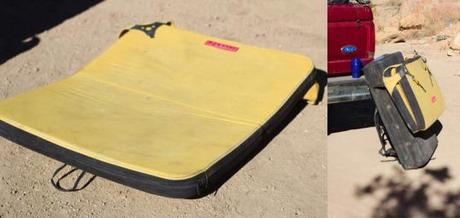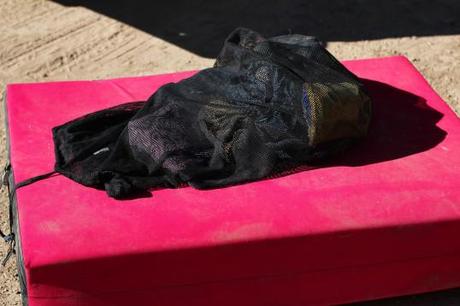I’ve been bouldering for about 8 years now. Shortly after starting to explore the Santa Barbara mountains with Chris Yorks and Dan Kovner, I invested in my first crashpad, a Franklin Dropzone. Since then I’ve had a multitude of foam, nearly all of which we’ve somehow brought along on the RV Project. We’ve got a good variety, and in going through them I see there are plusses and minuses to each. If you’re thinking of buying a new pad (or searching for a used one), think first about what you’ll mostly be using it for and what you might already have.
Mammut Soho

- 120 x 100 x 9 (cm) or about 48″ x 39″ x 3.5″
- It’s blue
- Three hooking metal buckles…weird closure system
I got this one as a freebie from a then-road-tripping Alex Johnson who didn’t have space in her car for this one. I can understand why. It has two taco folds instead of the usual one, and it folds into a triangle. This makes it, as far as I’m aware, the only crash pad that gets bigger when folded up. Two straps keep the sides together, and then a big diaper flap comes up from the bottom and attaches to the top, making for a big storage pouch. The flap also can be used to protect the shoulder straps from the dirt when the pad is in use.
The unique bi-fold design has major advantages. As a backpack, it’s easy: you just fold it up and toss everything in, and the flap keeps it there. The profile is narrow, making hiking through forest or the corridors of Hueco Tanks much easier. Also, because the two folds are at 60° instead of being folded all the way over, the foam will last a bit longer in the hinge region.
As far as I can see the main disadvantage is the car storage issue. In addition, the stitching on the diaper flap is a little weak, with the result that my flap is now far less bombproof in terms of holding stuff.
The carrying system could use a hip belt, but it has a chest buckle which helps. Otherwise, the shoulder straps are a little narrow and could use more padding. When you fill the pad with a gallon of water, shoes, lunch, and extra clothes and then hike for an hour, you feel it in the upper traps.
One last note on this one: Many other boulderers have watched me put the pad together and remarked that the closure system is dumb, or looks hard to manage. I used to think that too, but once you get the system down it’s no worse and maybe even a bit better than the standard system you see on Organics, Mad Rocks, etc. I think it’s just non-standard and funny looking, which frightens most people. Though I won’t deny that the diaper flap is a little goofy.

- 3′ x 4′ x 4″
- Pretty purple colors
- Big flap for help with closure
One thing I’ll give Organic is simplicity and quality. They use some of the best foam out there, and I know people with some old-ass Organics that still save ankles. They also have a sweet hybrid hinge that’s part taco, part hinge, which does well to mitigate the tendency for pads to rapidly fold in half when landed upon.
Vikki found hers on Craigslist, and of all the pads she’s tried, this is the only one she can comfortably carry. Perhaps it’s time for pad manufacturers to think about a female-specific carrying system. Guys would buy these for their girlfriends in a heartbeat…for me it would’ve meant that Vikki could carry more to Upper Chaos. The shoulder straps are pretty comfy, and it has both waist and chest buckles for tight fitting.
One minor peeve with Organic that I have is that I don’t like the hook/strap closures. They are kinda tough to loosen and not that easy to tighten. I also don’t think the flap is necessary. In theory you can put your wallet/keys/guidebook in there for safekeeping, but the chances are good that you’ll put your phone in there, forget about it, and land on it. The flap does help, though, because its length allows you to strap one pad to another and carry two of ‘em.
All in all, this pad is a very solid pad. And it’s all made in the USA. Pick your pattern and be a standout, just like a Scion driver!
Asana KJ Highball 2

- 60″ x 44″ x 5″
- Cam strap closure
This is the biggest pad we have. It’s also the most expensive, but we got a discount for helping Asana with a photo shoot. Designed by highball hero Kevin Jorgeson, it features 3″ of open cell (soft) foam sandwiched between two 1″ layers of closed-cell foam. This means that it can effectively be used upside-down, and handy thing for draping over boulders in the LZ. I have jumped from high up and this is the pad to land on.
The closure system is so simple it should be standard all over the place everywhere. It’s just some 1″ straps that you feed through camming buckles. Cinching is a cinch and loosening is as easy as hitting the button. There is no flap, and I was initially worried that things would tend to fall out the corners, but even when I have a bunch of loose small stuff in there it’s possible to keep it all in by tightening the straps a lot. (I try to avoid this, as it places lots of stress on the seams.)
Carrying this pad is a dream. The padded hip belt and contoured shoulder straps are what I wish I had when I was hopping talus in Colorado, but they work equally well for scrambling up loose hillsides on the “longer” approaches in Joe’s Valley.
This is just a well-made pad. The hybrid hinge works well of course, though they took out the anti-taco straps from the first KJ pad that would keep the pad stiff if you tightened them. I think they are planning on a KJ 3, and they’ll put the straps back on. There’s a little carpet corner for cleaning your shoes (which is clutch), and the handles are tubular webbing with a little plastic tube to give it shape. Little details like these make it a joy to bring the pad out.
Franklin/Black Diamond Dropzone
The goods
- 3′ x 4′ x 4″
- Blue was your only choice…now you have a few, I think
- Hooking metal buckles for closure
For an all-round beginner pad, it doesn’t get much better than this. The closure system (there are two, but they’re similar) is fairly simple and does a good job to insure that even the small stuff, like a guidebook, won’t fall out when you pack it up for the hike. It’s a taco-style (solid foam folded in half, instead of cut and hinged), which I generally prefer as it is less likely to fold in half and slam you in the face if you fall in the middle of an uneven landing.
I’ve had three of these, and the one main complaint is that the closure system is the first to fail on all of them, rendering them useless as backpacks. I’ve since used them as secondary pads, or as an extra in case a friend without a pad wants to join up.
A major bonus is that two of these makes just about a perfect bed. We’ve got them in the truck for that purpose.
Franklin Hipster Pad

- Little
- Only a shoulder strap
This little guy landed in our lap a while ago. I don’t know what it’s really called, as Franklin was bought by Black Diamond long ago, but since you can only carry it over one shoulder, the Hipster pad seems apropos. This one is worthwhile as a solo-circuiting pad, a little sit-starter, folded up as a hole-stuffer, or as a couch to sit on between burns. If you’re on a road trip, it’s a useful little guy to have, as you can strap it to your primary pad and give yourself a little more coverage. Even with Vikki and I, you’d be surprised at the difference between two pads and two and a half pads.
Some general comments about crash pads
Firstly, if you’re going to be hiking much more than 15 minutes or so, you’re going to want a hip belt. After climbing all day and hiking 2 hours out of Mt. Evans Area A, my traps were so sore with the Mammut pad. A couple of times my neck actually spasmed and I couldn’t climb for a few days afterward. Hip straps. Very good things.
Pads that don’t have flaps are prone to dropping stuff (especially guidebooks, due to their slim profile), but I personally would rather have all the design focus on making the pad simple and easy. If you pack smart, you don’t have to worry about it.

In this mesh bag you’ll find: 4 pairs of shoes, a 1st aid kit, a chalk bag, a chalk pot, and a set of rain gear. When we unpack at the boulders, the entire list becomes one item.
Packing a crash pad is sort of an art. Firstly, you want to stick your puffy jacket and extra clothes in the bottom and around the edges. Water bottles and the like go in next, and finally your guidebook (or whatever else is relatively fragile). We got ourselves a large mesh bag that we just toss all our shoes, chalk bags, and rain gear into. This guarantees that nothing can fall out, and when you get to the project, unpacking just means two or three items instead of a garage sale of shoes and such.
To summarize: Hip belts and mesh bags.
Also, if you go for a mega-big pad, like a Mondo or that giant Metolius, beware. Everyone loves having a friend with a Mondo…nobody wants to carry the Mondo. My friend Bryan got an Edelrid Crux, which, if you want to go big, might be the way to go. Check out his review here. The Crux seems to toe the line nicely between size and cumbersomeness.
Lastly, adding a smaller “butler” pad to your arsenal is strongly advised. They slide in to your regular pad, are perfect for lowballing, and can also be used to patch holes in your pad setup. Asana and Black Diamond both make some pretty good ones.
Anyway, these are just my opinions after spending a few months bouldering around the USA and seeing different kinds of pads and pad systems. Of course everything comes down to personal preference, but hopefully this’ll give you something to think about if you’re currently hunting for a pad.
What’s your favorite pad? What pad features do you love? What pad features do you hate? Leave a note!
